Some information about the just-launched E-ticketing platform for the Nigeria Railway Corporation (NRC)
#Thread
#Thread
The contract is for the “Design, Development, Deployment and Management” of a “Secure Automated Fare Collection System” for the NRC.
According to @icrcng and @MinTransportNG, it’s a 10-year Public Private Partnership (PPP) contract, funded by the contractor, @secureidltd

According to @icrcng and @MinTransportNG, it’s a 10-year Public Private Partnership (PPP) contract, funded by the contractor, @secureidltd


“This is a PPP where the private sector will invest money to develop, deploy and operate an integrated ticketing solution.” — DG @icrcng on the day he presented the Full Business Case (FBC) Certificate for the concession of the E-ticketing system to @ChibuikeAmaechi, Sept 2019. 

Sept 2019: “This transaction is for 10 years within this period, the financial model shows that NRC and @NigeriaGov will earn over N16 billion as revenue from the ticketing system.” — Chidi Izuwah, DG @icrcng m.guardian.ng/features/autom…
NB. The Infrastructure Concession Regulatory Commission (ICRC) is the agency of @NigeriaGov established “to regulate Public Private Partnership (PPP) endeavours of the Federal Government”, under the ICRC (Establishment, etc) Act, 2005. icrc.gov.ng/about-icrc/
.@secureidltd, the concessionaire (through subsidiary @TPSsolution), is a Nigerian company that produces Visa & MasterCards for banks operating across several African countries. I believe they were the first EMV-certified (“Europay, MasterCard, Visa”) plant in sub-Saharan Africa.
SecureID also manufactures SIM cards for Telcos. Chances are the (Nigerian) SIM in your phone right now was manufactured by the company: lionessesofafrica.com/blog/2017/1/8/…
secureidltd.com/telecoms
secureidltd.com/telecoms
Minister’s tweet about the scope of the ticketing platform (software and hardware):
- Mobile App
- Website
- POS / Cash at Station
- Ticket Validators
- Self-Service Vending Machines at Stations (in-progress)
- Mobile App
- Website
- POS / Cash at Station
- Ticket Validators
- Self-Service Vending Machines at Stations (in-progress)
https://twitter.com/chibuikeamaechi/status/1352287139954884612
Very important to understand that the Automated Fare Collection system includes not just a website/app but also operating software for the system, as well as lots of hardware—vending machines, speedstiles, servers, civil works at stations,etc, AND 10-year operation & maintenance. 

Minister of Transport @ChibuikeAmaechi speaking at the launch event.
Summary: Concessionaire (@secureidltd) invested its own money into the project, and is expected to deploy, operate & maintain the system for 10 years, recoup its investment, and then ownership reverts to NRC.
Summary: Concessionaire (@secureidltd) invested its own money into the project, and is expected to deploy, operate & maintain the system for 10 years, recoup its investment, and then ownership reverts to NRC.
Sept 4, 2019: The day @icrcng - which vets and approves all PPP/concession projects of @NigeriaGov - presented the FBC Compliance Certificate for the Automated Fare Collection System to the Ministry of Transportation. An important milestone in the procurement process.
https://twitter.com/icrcng/status/1169273642276073472
This is from the @icrcng website - from the procurement process for the Automated Fare Collection system. There was a Preferred Bidder - SecureID, and also a Reserve Bidder - which is basically a stand-in, in case the Preferred bidder is unable to proceed with the contract. 

• • •
Missing some Tweet in this thread? You can try to
force a refresh



















